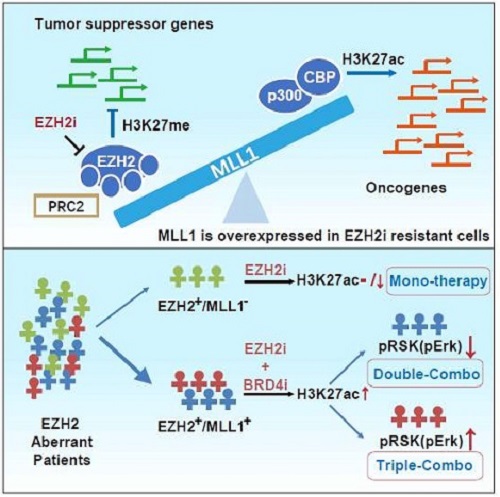


Scientists from the Shanghai Institute of Materia Medica (SIMM) of the Chinese Academy of Sciences made new progress in revealing the mechanisms that essentially determine the therapeutic response to EZH2 inhibitors, proposing biomarker-guided therapeutic solutions for EZH2-aberrant solid tumors.
The abnormal epigenetic regulation is closely related to the prognosis of a variety of human tumors. EZH2, a histone methyl transferase subunit of a Polycomb repressor complex, is recurrently mutated in several forms of cancer and is highly expressed in numerous others.
Nevertheless, both preclinical and clinical evidence suggests the very limited benefit of EZH2-targeted therapies in both hematological and solid tumors. There appears to be an apparent disparity between the recurrent EZH2 aberrations in human cancers. Indeed, only small sets of cancers benefited from the treatment. Thus, there remains a major barrier in translational medicine for EZH2 targeted therapies.
Scientists from SIMM discovered that EZH2 inhibition could lead to a global landscape change of histone marks.
Among the globally altered histone marks, a specific interplay between methylation and acetylaton on histone H3 lysine 27 (H3K27me-H3K27ac) was noted and shown to be critical for determining the drug response to the EZH2 inhibition via H3K27ac associated transcriptional output.
The study further substantially extended earlier observations, revealing that a methyl transferase, mixed-lineage leukemia 1 (MLL1), plays a key role in allowing the occurrence of H3K27ac.
MLL1 forms a complex with p300 and facilitates p300-catalyzed H3K27ac upon PRC2 inhibition.
The intrinsic MLL1 level varies between the different cancers which explains the differential H3K27ac response between cancer cells despite the similarly suppressed H3K27me level.
Importantly, this work reveals that concurrent inhibition of H3K27 methylation and acetylation results in transcriptional repression and, in certain cancer subsets, MAPK pathway dependency.
With study in pre-clinical models encompassing a broad spectrum of EZH2-aberrant solid tumors, SIMM scientists demonstrated that strategies including a combination of EZH2 and BRD4 inhibitors or a triple-combination including MAPK inhibition display robust efficacy with very tolerable toxicity.
This finding was published in Cell (online on Sept 13, 2018).
For more information, please contact:
Huang Xun
Shanghai Institute of Materia Medica, CAS
Email: xhuang@simm.ac.cn
(Credit: Huang Xun; Editor: Pan Peihua)